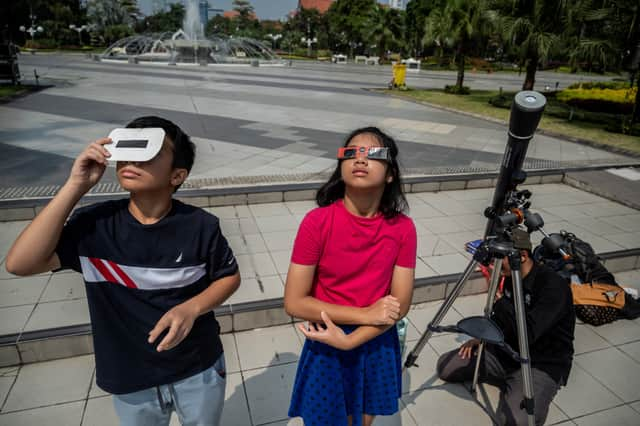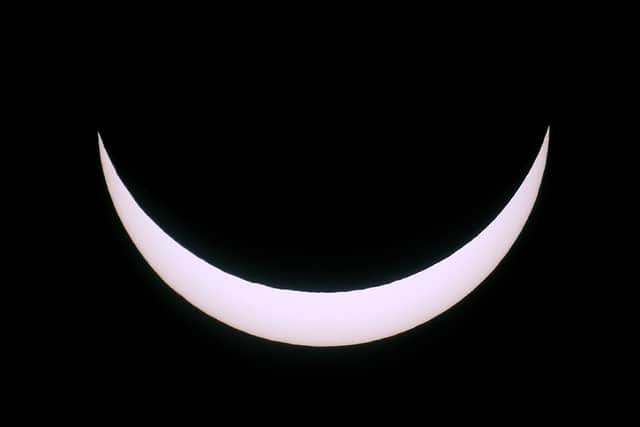UK solar eclipse: when was last total solar eclipse in the UK, when is the next one - hybrid eclipse explained
and live on Freeview channel 276
On Thursday (20 April), a rare “hybrid” solar eclipse that briefly cast part of Australia’s northwest coast into darkness at midday was witnessed by about 20,000 eclipse chasers under a clear sky.
Exmouth, an isolated tourist destination with fewer than 3,000 residents, was advertised as one of the best locations in Australia to view the eclipse, which also passed through secluded areas of East Timor and Indonesia and brought a brief drop in temperature.
Advertisement
Hide AdAdvertisement
Hide AdThe hybrid solar eclipse tracked from the Indian Ocean to the Pacific Ocean and was mostly over water. The lucky few people in its path either saw the darkness of a total eclipse or a “ring of fire” as the sun peeked from behind the new moon.
Such celestial events happen about once every decade - the last one was in 2013 and the next one is not until 2031. But when was the last solar eclipse to be witnessed closer to home in Britain, and when will the next one fall? Here is everything you need to know.
What is a ‘hybrid’ eclipse?


The difference between a total and an annular eclipse is determined by the relative positions of the Sun, Moon, and Earth during the eclipse.
In a total solar eclipse, the Moon passes directly between the Sun and the Earth and completely blocks the Sun’s disk, causing the sky to darken and revealing the Sun’s corona. Total solar eclipses can only occur when the Moon is at a certain distance from the Earth and appears to be the same size as the Sun in the sky.
Advertisement
Hide AdAdvertisement
Hide AdIn an annular solar eclipse, the Moon is slightly farther away from the Earth and appears slightly smaller than the Sun in the sky. As a result, when the Moon passes in front of the Sun, it does not completely block the Sun’s disk. Instead, a ring, or “annulus,” of the Sun’s disk remains visible around the Moon, resulting in a “ring of fire” effect.
Both total and annular solar eclipses are spectacular astronomical events, but the experience of viewing them is quite different. In a total solar eclipse, the sky goes completely dark, and the corona of the Sun is visible, while in an annular solar eclipse, a ring of bright sunlight remains visible around the Moon.
A hybrid solar eclipse, also known as an annular-total eclipse, is a rare type of solar eclipse that transitions between a total solar eclipse and an annular solar eclipse along its path of totality, the track or narrow strip on the Earth’s surface where the Moon completely blocks the Sun.
During a hybrid solar eclipse, the Moon’s distance from the Earth and its size relative to the Sun change as it moves across the Sun’s disk. This causes the eclipse to begin as an annular eclipse, with a ring of sunlight visible around the Moon, and then transition to a total eclipse, where the Moon completely blocks the Sun’s disk.
Advertisement
Hide AdAdvertisement
Hide AdThe path of totality for a hybrid solar eclipse is relatively narrow, and the transition from an annular to a total eclipse and vice versa can occur quite quickly, sometimes lasting for only a few seconds.


When is the next total eclipse in Britain?
Several other upcoming solar eclipses will be easier to catch. An annular eclipse in mid-October and a total eclipse next April will both cross over millions of people in the Americas. But when will the next British eclipse be?
Well, there’s a few years to wait yet, and the next annular eclipse visible from the UK won’t take place until 11 June 2048. Even then, the best results will be seen just north of Shetland, though mainland Britain will see the Moon cover roughly 60% of the Sun.
Until then, there are numerous partial eclipses expected to take place, though some will be more noticeable than others. Next year, a partial eclipse may be visible from parts of Britain just before sunset on 8 April 2024, and another covering 40% - 50% of the Sun will take place on 29 March 2025.
Advertisement
Hide AdAdvertisement
Hide AdThe year after that, there is an exciting partial eclipse expected to be visible from the UK, one that will see 96% of the Sun covered by the Moon. The eclipse on 12 August 2026 will be total across Iceland, the Atlantic Ocean and Spain, though it will result in a “large” partial eclipse across Britain, with western locations best poised to see it.
The next total eclipse to be easily observable by the majority of the UK will take place on 23 September 2090. That eclipse will follow a track similar to the total eclipse observed in the UK on 11 August 1999, but shifted slightly further north and occurring very near sunset.
What happened in 1999?
The total solar eclipse of 11 August 1999 was a significant astronomical event, and was the last total solar eclipse seen in the UK (indeed, it was the last total solar eclipse visible from Europe until 2026).
The path of totality passed over parts of Cornwall, Devon and South Wales, with areas around the town of Penzance in Cornwall experiencing the longest period of totality .
Advertisement
Hide AdAdvertisement
Hide AdThe eclipse began in the southwest of England at around 10am, reached totality at around 11.10am, and ended in the northeast of Scotland at around 12.30pm.
The rare and awe-inspiring event attracted a lot of attention from the public, scientists and astronomers. Many people travelled to the UK specifically to view the eclipse, and some estimates suggest that over 300,000 visitors came to Cornwall alone.
Of course, British weather being what it is, the celestial phenomenon was almost universally clouded out on the mainland, though clouds did clear in the Newquay area, allowing observation of full totality.
Observers there experienced the eerie sensation of day turning to night for a couple of minutes, with birds falling silent and the temperature dropping noticeably. After totality ended, the Sun gradually reappeared from behind the Moon, and viewers were able to observe a partial eclipse until the Moon had completely passed by the Sun.
Advertisement
Hide AdAdvertisement
Hide AdThere were concerns about the potential impact of the eclipse on the UK’s electricity grid, as the sudden drop in solar power could cause a surge in demand. However, these fears proved to be unfounded, and the eclipse had no significant impact on the grid.
Comment Guidelines
National World encourages reader discussion on our stories. User feedback, insights and back-and-forth exchanges add a rich layer of context to reporting. Please review our Community Guidelines before commenting.
